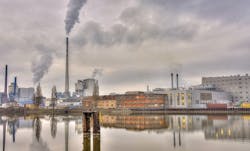More Than 40% of Michigan Industrial Facilities Exceed Water Pollution Limits
According to a new study executed by Environment Michigan and Frontier Group, more than 40% of Michigan’s major industrial facilities polluted waterways beyond legal limits over the period of study, which took place over a 21-month period until September 2017.
The study claims that 32 of 77 Michigan industrial sites emitted water pollution that was not compliant with the Clean Water Act, including 20 with multiple offenses. The study uncovered a total of 196 egregious discharges.
Pollutants found within the various discharges included, hydrogen sulfide, chlorine, oil and grease, mercury and fecal coliform.
Nathan Murphy, state director for Environmental Michigan, claims the matter is an issue of accountability and regulation.
“All Michigan lakes and streams should be clean for swimming, drinking water and wildlife,” Murphy said. “But industrial polluters are still dumping chemicals that threaten our health and environment, and no one is holding them accountable.”
The report also claims a widespread failure by Michigan regulators to review compiled discharge data from the subject industrial facilities. It also analyzed nationwide enforcement data, concluding that less than half of non-compliant facilities failed to meet any penalties by the U.S. EPA from 2011 to 2017.
